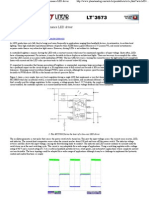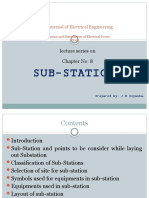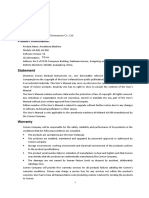Solar Induction Cooker PDF
Solar Induction Cooker PDF
Uploaded by
Lakshmanan ThangaveluCopyright:
Available Formats
Solar Induction Cooker PDF
Solar Induction Cooker PDF
Uploaded by
Lakshmanan ThangaveluOriginal Title
Copyright
Available Formats
Share this document
Did you find this document useful?
Is this content inappropriate?
Copyright:
Available Formats
Solar Induction Cooker PDF
Solar Induction Cooker PDF
Uploaded by
Lakshmanan ThangaveluCopyright:
Available Formats
3rd International Conference on Electronics, Biomedical Engineering and its Applications (ICEBEA'2013) April 29-30, 2013 Singapore
Solar Based Induction Cook Top
Anuge Sarine Francis#, Bhavana Ffion, Faseen.K., and Hema Mohan
Abstract--- One of the most threatening problems that we are to
witness in future is the scarcity of cooking gas. An alternate method
is to reckon upon electricity for the purpose. But the extensive
upsurge in the price of electricity and the lack of availability of large
amount of electricity forces us to think about yet another alternative.
So we come up with a project which is all about replacing
conventional sources of energy which are gradually being extinct
with renewable energy sources munificent in nature. This paper
explains how we can adapt this to our cooking system, i.e., using
solar energy to cook faster, easier and cheaper compared to other
cooking systems.
Fig 1.Block Diagram
Keywords - Induction cook top, solar, renewable energy, solar
based system, induction, sustainable energy.
A. Solar Panel
Solar panel is a compiled and connected assembly
of photovoltaic cells that transmutes solar energy into
electrical energy [1]. It can be used as a constituent of a bigger
photovoltaic system to create and distribute electricity in
mercantile and residential applications. Each panel is rated in
accordance with its DC output power under standard
conditions, and typical specification ranges from 100 to 320
watts. We espouse a collection of 200 watt panels to form
1000 watts.
The conjectured efficiency of these panels are 80% and thus
we could postulate that a figure of 800 watts may be collected
from this section.
A photovoltaic system conventionally comprehends an
array of solar panels, an inverter, and an optional battery.
I. INTRODUCTION
URING this fast life era we all depend on the latest and
cheapest technology that would make our life more
befitting, comfortable and dynamic. So we choose a
project which could improvise the extant technology with
some ancillary addendums. That is implementing an induction
cook top that could completely reckon on solar energy.
Solar energy has always been vital for mankind. With
augment in anxiety in conventional energy sources, renewable
sources such as solar energy are gaining enormous
significance. One ilk of solar energy is the photovoltaic (PV)
technology that transmutes solar energy to electric energy by
the virtue of solar cells. The photovoltaic energy is either
implemented as a stand-alone energy source or allied to the
grid as distributed energy generation. Thus we can say that in
near future almost all of our energy consumption will be based
on sunlight that is nothing but solar energy .
B. Battery
A storage battery is an ilk of electrical battery. It is a genre
of energy accumulators comprising of more than one
electrochemical cells[2]. It is known as a secondary cell since
its electrochemical reactions are electrically rescindable.
Rechargeable batteries are used by grid energy
storage applications for load-levelling, where they accumulate
electric energy. For sustainable energy uses, the energy stored
during day time can be used during peak load hours at night.
Load-levelling mitigates the eradication of the desideratum for
expensive culminating power plants and aids in amortizing the
cost.
We use a couple of batteries, each of 12V and 150Ah
capacity forming 24V and 300Ah capacity. This generates 4
hours of output approximately at night without charging.
II. BASIC BLOCK DIAGRAM
The whole system is completely lucid and easy to install.
The basic block diagram of a solar based induction cook top
shown in thsi figure. Here are the different block such as solar
panel , battery , inverter and control circuit and induction
cooktop in the diagram explained in details. Let us see each
block in detail.
C. Inverter
A power inverter is a converter which transmutes direct
current (DC) to alternating current (AC). The converted output
can be made to any voltage and frequency according to the
applications and desiderata.
Anuge Sarine Francis#, Bhavana Ffion, Faseen.K., and Hema Mohan are
with Department of Electronics and Communication Engineering Federal
Institute of Science and Technology. Angamaly , Kerala ,India.
#
Corresponding author: Anuge Sarine Francis anugefrancis. email:
francis@gmail.com
185
3rd International Conference on Electronics, Biomedical Engineering and its Applications (ICEBEA'2013) April 29-30, 2013 Singapore
We use a 1.5kVA inverter with standard output
specifications of 230V, 50Hz to suit our requirements.
avoid overheating and detonation of batteries due to
any upsurge in current flow.
D. Control Circuit
In the system there must be a scheme to detect when a cell
reaches full charge (change in terminal voltage, temperature,
etc.) and to stop charging before harmful overcharging or
overheating occurs[3]. We can incorporate cooling fans if
needed to keep the cells from heating. Here we use a control
circuit with voltage level sensors to obviate a detonation.
The photograph of the control circuit is shown in figure 2.
E. Induction cook top
Induction cooking makes use of induction heating to heat
a metal cooking vessel directly, rather than transferring
heat from a flame as with an accustomed cooking stove. For
almost all models of induction cook top, the cooking pot must
be manufactured using a ferromagnetic metal, or an interface
disk should be used to enable non-induction cookware to be
used instead of ferromagnetic cookwares.
In an induction cooktop, a copper coil is placed underneath
the cooking pot. An alternating electric current flows through
the coil, which produces an oscillating magnetic field[5]. This
field induces an electric current in the pot. Current flowing in
the metal pot produces resistive heating which heats the food.
While the current is large, it is produced by a low voltage. An
induction cooker is faster and more energy-efficient than the
traditional methods of cooking.
III. STUDY
The contemporary energy sources for cooking are
LPG(Liquid Petroleum Gas) and electricity. Cooking gas is on
a verge of paucity in the country and reckoning on it for
cooking in future will be quixotic. A number of electric
cooking stoves and induction cook tops are already in use for
small and quick cooking[6]. But espousing it as a source for
unabridged cooking chores in a house will pave the way for
very high consumption of electrical energy and thereby
elevate monthly energy charges or electricity bill[7]. So as a
wise alternative, we can adopt solar energy to generate
adequate electricity for an induction cook top to work so as to
carry out a whole days cooking. So in future it will save a lot
of energy. The table which shows the energy consumption and
the price hike in the near past is shown.
Fig 2. Control Circuit
1)
Microcontroller and Buzzer: Microcontrollers are
designed for small devoted applications. PIC is
initially gleaned from PIC1640 developed by General
Instruments Microelectronic Division. It became a
family of Harvard Achitecture by Microchip
technologies. The name PIC is the abbreviation for
Programmable Interface Controller. We use a 40
pin PIC, 18F4550 to control all the processes such as
charging, monitoring etc. A buzzer is a mechanical,
electromechanical or piezoelectric signaling device
which alerts through an audio signal. Here we use the
same to beep when the battery charge comes under a
threshold.
TABLE I
PRICE HIKE IN COOKING GAS AND ELECTRICITY
2) Voltage sensing and Current sensing Unit: We are
using voltage divider setup to measure the battery
voltage and a shunt resistor and operational amplifier
setup for measuring the current driven from solar
energy.
3) Graphical Lcd and Switching circuit: The Graphical
LCDs are capable of displaying customized images
and characters[4]. The Graphical LCDs can be used
in a number of applications such as in mobile phones,
video games etc. The GLCD in our circuit has a
display format of 128x64 dots and has yellow-green
colour backlight. It is divided equally into two halves
controlled each controllers and consists of 8 pages.
Each page comprises of 8 rows and 64 columns. The
switching circuit is employed using metal oxide
semiconductor field effect transistors(MOSFETs) to
Table I shows the price upsurge in cooking gas and
electricity from the year 2002 to 2012. During these 10 years,
the price of these commodities has increased beyond a linear
rate making it streneous for common people to reckon upon
these sources. The price hike has been elevated during the past
4 years and signs show us that it will increase in a bigger rate
in near future.
186
3rd International Conference on Electronics, Biomedical Engineering and its Applications (ICEBEA'2013) April 29-30, 2013 Singapore
In this paper, we implement a solar based system and find
out the feasibility of the idea and the monetary profits of using
it rather than using electric supply for cooking, as cooking gas
is almost unavailable.
From calculations it is estimated that by using solar based
induction cook top for complete cooking in a house, one can
reap back the whole installation expenses in nearly 5 years and
every year after that, he save an amount of Rs. 12000.
cooking purpose. This is what we think makes this project
important and acceptable.
IV. CONCLUSION
The topic selected in the renewable energy resources area is
relevant and productive to match the current scenario of
REFERENCES
[1]
[2]
[3]
[4]
[5]
Fig. 1 Bar graph showing the expense per month for cooking using
gas, electricity and Solar based induction cooktop
[6]
The bar graph shown above explains the desideratum for
such a paper in current scenario. The expense of
cooking+electricity using cooking gas is nearly Rs. 1250 per
month and that using only electricity is nearly Rs. 1550 per
month[8]. By espousing our Solar Based Induction Cook Top,
we need to spend only the initial installation cost of around
Rs.60000. After that for years we need not spend a penny for
[7]
[8]
187
A.Zahedi, "Energy, People, Environment, Development of an
integrated renewable energy and energy storage system, an
uninterruptible power supply for people and for better environment,"
The International Conference on Systems, Man, and Cybernetics, 1994.
'Humans, Information and Technology', Vol. 3 pp. 2692-2695, 1994.
Ahmad Yafaoui, Bin Wu and Richard Cheung, Photovoltaic energy
Systems-An Overview, IEEE Canadian Review-Spring/Printemps 2009.
Cousins PJ,Smith DD, Luan HC, Manning J, Dennis TD, Waldhauer A,
Wilson KE, Harley G and Mulligan GP, Gen III:Improved performance
at lower cost, 35th IEEE PVSC, Honolulu, HI, June 2010.
James P.Dunlop, Batteries and Charge Control in StandalonePhotovoltaic Systems:Fundamentals and Applications, 15th Jan
1997.
E. Karatepe, T. Boztepe, and M. Colak, "Power Controller Design for
Photovoltaic Generation System under Partially Shaded Insolation
Conditions", The International Conference on Intelligent Systems
Applications to Power Systems, pp. 1-6, 2007.
B. Hall "Paralleling MOSFETs Successfully", Electronic Products
Magazine, 1985
A.M. Sharaf and A.R.N.M. Reaz Ul Haque, "A stand alone photovoltaic
(ac) scheme for village electricity," 31st Photovoltaic Specialists
Conference and Exhibition, January 3-7, 2005, Florida (Accepted)
A.I. Martinez and H. Calleja, "A simple, high-quality output PV system
aimed at peak demand reduction," in Conference Publication of the VII
IEEE international Power Electronics Congress, CIEP 2000, 15-19 Oct.
2000, pp.301-306.
You might also like
- Final Job Card FormatDocument32 pagesFinal Job Card FormatSyed Mujtaba Ali Bukhari75% (4)
- Solar Inverters PDFDocument8 pagesSolar Inverters PDFRajesh Kumar MamidiNo ratings yet
- Literature Review of Gan, Ldmos and DC-DC Buck Converter: Author-Rishabh Soni (T19125)Document3 pagesLiterature Review of Gan, Ldmos and DC-DC Buck Converter: Author-Rishabh Soni (T19125)t19125 t19125No ratings yet
- Metal Furring System PDFDocument4 pagesMetal Furring System PDFJane Christy PensergaNo ratings yet
- Grid-Integrated and Standalone Photovoltaic Distributed Generation Systems: Analysis, Design, and ControlFrom EverandGrid-Integrated and Standalone Photovoltaic Distributed Generation Systems: Analysis, Design, and ControlNo ratings yet
- Module 4: Substation Equipment's Details and Operations: July 2021Document14 pagesModule 4: Substation Equipment's Details and Operations: July 2021Gundeboyina GopiNo ratings yet
- Final Report PDFDocument23 pagesFinal Report PDFSanjay GowdaNo ratings yet
- Make A Difference With Blue GISDocument16 pagesMake A Difference With Blue GISDan StreetNo ratings yet
- Mini Tesla Coil Project PDFDocument11 pagesMini Tesla Coil Project PDFDrishti Uppal100% (1)
- DC-DC ConvertersDocument37 pagesDC-DC ConvertersNeethu Elizabeth MichaelNo ratings yet
- Solar Based Induction CooktopDocument5 pagesSolar Based Induction CooktopSunil MåüřÿäNo ratings yet
- DC DC ConvertorDocument11 pagesDC DC ConvertorJyothiNo ratings yet
- Information About PVDocument44 pagesInformation About PVpasistNo ratings yet
- Invisible Broken Wire DetectorDocument1 pageInvisible Broken Wire DetectorRev. MatthewNo ratings yet
- A Modified Quadratic Boost Converter Wit PDFDocument6 pagesA Modified Quadratic Boost Converter Wit PDFkadr sherpaNo ratings yet
- Ev - Part 07 - Electric MachinesDocument27 pagesEv - Part 07 - Electric MachinesKadir YavuzNo ratings yet
- The Difference Between GaN and SiC Transistors 1713331034Document7 pagesThe Difference Between GaN and SiC Transistors 1713331034im.pavantomarNo ratings yet
- Design and Implementation of Practical Induction Heating CookerDocument4 pagesDesign and Implementation of Practical Induction Heating Cookerzahid hussainNo ratings yet
- Automatic Frequency Control of An Induction FurnaceDocument4 pagesAutomatic Frequency Control of An Induction FurnaceNarendra BholeNo ratings yet
- (GOB) 1ZSE 2750-102 en Rev 7cDocument24 pages(GOB) 1ZSE 2750-102 en Rev 7cThiagoPinheiroNo ratings yet
- Types of TransformersDocument16 pagesTypes of TransformersTahamee SHAIKHNo ratings yet
- Central Electricity Authority (Measures Relating To Safety and Electric Supply) Regulations, 2023Document84 pagesCentral Electricity Authority (Measures Relating To Safety and Electric Supply) Regulations, 2023Yaddala Chandra SekharNo ratings yet
- Reference Guide To Wide Bandgap SemiconductorsDocument1 pageReference Guide To Wide Bandgap SemiconductorsKiril KolesnikovNo ratings yet
- Reg316 4eDocument980 pagesReg316 4ejgerand100% (1)
- What Is Induction CookerDocument8 pagesWhat Is Induction CookerprivacymNo ratings yet
- GIS 8DN84 Ds eDocument2 pagesGIS 8DN84 Ds eElmer Gonzalo Sullca ZapataNo ratings yet
- Low Power Sub-1 GHZ RF TransmitterDocument61 pagesLow Power Sub-1 GHZ RF Transmitterkamesh_patchipala9458No ratings yet
- Isoloop Magnetic CouplerDocument26 pagesIsoloop Magnetic CouplerVarun Pathak100% (8)
- Indian Power ScenarioDocument69 pagesIndian Power ScenarioManoj JhaNo ratings yet
- Design A LED DriverDocument2 pagesDesign A LED DriverKok Weng Loo100% (1)
- Buck Boost Transformer - Push Pull TransformerDocument4 pagesBuck Boost Transformer - Push Pull Transformermaka27No ratings yet
- Project Report Bukenya Sem 4 2024Document41 pagesProject Report Bukenya Sem 4 2024edwinhunt256No ratings yet
- Ac Contro Llers For High Frequency Induction HeatingDocument5 pagesAc Contro Llers For High Frequency Induction HeatingAmarsingh ChoudharyNo ratings yet
- Impact of Rain On Insulation PerformanceDocument4 pagesImpact of Rain On Insulation Performancedes1982No ratings yet
- Pages From (MiCOM P54x - EN M - La4 Technical Manual 120911)Document6 pagesPages From (MiCOM P54x - EN M - La4 Technical Manual 120911)dvnishshankaNo ratings yet
- "Gas Insulated Substation: An Overview": Powergrid Corporation of India LimitedDocument35 pages"Gas Insulated Substation: An Overview": Powergrid Corporation of India LimitedSaurabh KumarNo ratings yet
- cc1120 Radio Transciever DatasheetDocument37 pagescc1120 Radio Transciever Datasheeth1238709mNo ratings yet
- Two-Stage Micro-Grid Inverter With High PDFDocument10 pagesTwo-Stage Micro-Grid Inverter With High PDFacostaricciNo ratings yet
- MobileDocument31 pagesMobileTELECOM INJINIYANo ratings yet
- Unit III: Line InsulatorsDocument48 pagesUnit III: Line InsulatorsVenkatesh KumarNo ratings yet
- 2013 Li Pyroelectric and Electrocaloric MaterialsDocument15 pages2013 Li Pyroelectric and Electrocaloric MaterialsNacho Delgado FerreiroNo ratings yet
- Planar Inductor 1987Document3 pagesPlanar Inductor 1987Nedelcu100% (1)
- Capacitor Voltage TransformerDocument1 pageCapacitor Voltage TransformeranuragpugaliaNo ratings yet
- ASAT ConfigPro TrainingDocument99 pagesASAT ConfigPro Trainingrommel76100% (1)
- Building N AutomationDocument56 pagesBuilding N AutomationkrsrchoudaryNo ratings yet
- Best Practices in Solar PhotovoltaicsDocument43 pagesBest Practices in Solar Photovoltaicsphilipnart100% (1)
- A Novel Single Phase Cascaded H-Bridge Inverter With Reduced Power Electronics SwitchesDocument8 pagesA Novel Single Phase Cascaded H-Bridge Inverter With Reduced Power Electronics SwitchesHemanth KumarNo ratings yet
- Sub-Stations: Departmental of Electrical EngineeringDocument41 pagesSub-Stations: Departmental of Electrical EngineeringJAYESH100% (1)
- Communication Technologies Augmenting Power TransmissionDocument54 pagesCommunication Technologies Augmenting Power TransmissionChaitanyaVig100% (1)
- Power Theft by IOTT 1Document11 pagesPower Theft by IOTT 1Manoj KolliparaNo ratings yet
- IgctDocument3 pagesIgctNavaneethaan Nathamoorthy100% (1)
- Bi-Directional Solar Inverter CatalogueDocument4 pagesBi-Directional Solar Inverter Cataloguevineets058No ratings yet
- Design of Solar Panel As Wind Turbine BladesDocument12 pagesDesign of Solar Panel As Wind Turbine BladesIJRASETPublicationsNo ratings yet
- Application of Flexible AC Transmission System Devices in Wind Energy Conversion SystemsFrom EverandApplication of Flexible AC Transmission System Devices in Wind Energy Conversion SystemsNo ratings yet
- SoNator Final PaperDocument15 pagesSoNator Final PaperGenesis MedelNo ratings yet
- Solar ProjectDocument61 pagesSolar Projectwww.sangug06No ratings yet
- UPS SystemDocument45 pagesUPS SystemRavi TejaNo ratings yet
- 014 - PP 747-754Document8 pages014 - PP 747-754Patrick John AbellaNo ratings yet
- ME505 Assignment 2 T3 2022Document4 pagesME505 Assignment 2 T3 2022Kavindu PereraNo ratings yet
- Toyota Forklift 7fgf15 to 7fdjf35 Repair ManualDocument24 pagesToyota Forklift 7fgf15 to 7fdjf35 Repair ManualmynessketofyNo ratings yet
- Material Number Field Length Extension - General InformationDocument7 pagesMaterial Number Field Length Extension - General InformationRoberto CastilloNo ratings yet
- Aswathy AchuDocument8 pagesAswathy AchugeethaNo ratings yet
- The Human Respiratory SystemDocument15 pagesThe Human Respiratory SystemNandita Halder100% (1)
- Fatigue Life of The 316L Stainless Steel Based On Dual-Parametric Weibull DistributionDocument10 pagesFatigue Life of The 316L Stainless Steel Based On Dual-Parametric Weibull DistributionMr PolashNo ratings yet
- Module Week 1 8Document78 pagesModule Week 1 8jan ray aribuaboNo ratings yet
- Comparative Analysis of HDFC Bank and SBIDocument37 pagesComparative Analysis of HDFC Bank and SBIsiddhantkamdarNo ratings yet
- Wind Energy Investigation in Northern Part of Kudat, MalaysiaDocument9 pagesWind Energy Investigation in Northern Part of Kudat, MalaysiaAliashim Albani AllianNo ratings yet
- LP12 180Document2 pagesLP12 180brobataNo ratings yet
- Safe Grease 2Document22 pagesSafe Grease 2ivancho310No ratings yet
- LogDocument117 pagesLogÁlvaro KramarNo ratings yet
- CHAPTER 1: An Overview of Organizational BehaviorDocument29 pagesCHAPTER 1: An Overview of Organizational BehaviorJessie jorgeNo ratings yet
- User Manual AX 400.AX 500Document180 pagesUser Manual AX 400.AX 500Mayra Marmolejo VargasNo ratings yet
- An Algorithm For Three-Phase Equilibrium CalculationsDocument8 pagesAn Algorithm For Three-Phase Equilibrium CalculationsJosé Arturo Tlapaltotoli PanecatlNo ratings yet
- Worksheet 3Document2 pagesWorksheet 3Ira G. Delos SantosNo ratings yet
- Duaso QuizDocument20 pagesDuaso QuizCharchar HernandezNo ratings yet
- Shubh UBC Prompt Engineering AssignmentDocument9 pagesShubh UBC Prompt Engineering AssignmentMadhav ChananaNo ratings yet
- 12 CA EM Answer Key NSDocument6 pages12 CA EM Answer Key NSmalathi SNo ratings yet
- Bacteriolgy Catalase (+), Gram (+) Cocci Part 1Document4 pagesBacteriolgy Catalase (+), Gram (+) Cocci Part 1Shaniah xxNo ratings yet
- Group Leisure and Travel-December 2022Document44 pagesGroup Leisure and Travel-December 2022Tobei AchimNo ratings yet
- 2018 Hogue Ar15Document12 pages2018 Hogue Ar15remi GALEANo ratings yet
- C011206551 Microsoft Antitrust CaseDocument13 pagesC011206551 Microsoft Antitrust Caseburhan indradiNo ratings yet
- Experiment No:06 Whirling of Shaft: Kinematics and Dynamics Lab Manual (ME406ES)Document5 pagesExperiment No:06 Whirling of Shaft: Kinematics and Dynamics Lab Manual (ME406ES)Ameer Hamza KhanNo ratings yet
- APWHM Units 3 and 4 Notes TemplateDocument19 pagesAPWHM Units 3 and 4 Notes TemplateFrederick 018No ratings yet
- 02 MenangitisDocument4 pages02 MenangitisMaeen Gamal AlhadhramiNo ratings yet
- Task 2: David Santiago Rivera LombanaDocument4 pagesTask 2: David Santiago Rivera LombanaSantiagoNo ratings yet
- Rohith Kevin Personal CaseDocument12 pagesRohith Kevin Personal Casekaicobra417No ratings yet

























































































